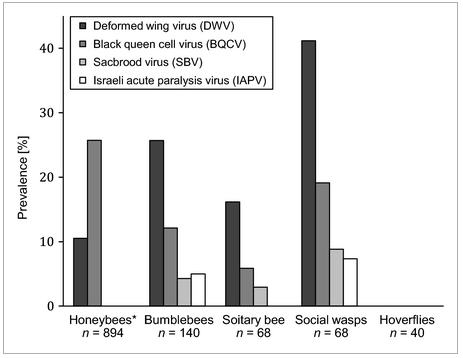A new review of other studies concludes that viruses carried by commercial bees can jump to wild pollinator populations with potentially devastating effects. Pollinators in some regions have suffered declines and various hypotheses have been offered as to why.
The researchers reviewed existing studies to determine the potential for disease emergence within wild pollinator communities based on known honey bee viruses. The main culprit of disease-related losses from commercial honeybee colonies is the Varroa mite. This parasite helps spread viral diseases and may increase their virulence.
One of these viruses - the Deformed Wing Virus - has recently been identified as an emerging disease in pollinators and its prevalence in commercial honeybees has been linked to its existence in wild bumblebees. The social behavior of honeybees, bumblebees and social wasps, provides perfect conditions for disease transmission both within the colony and between different species.

Cumulative percentage prevalence of DWV, BQCV, SBV and IAPV across pollinator species groups. *Note that ‘honeybees’ exclude A. mellifera – (data from Singh et al. 2010; Evison et al.
2012; Li et al. 2012; Zhang et al. 2012; Levitt et al. 2013), n = total number of individuals sampled within each species group.
DOI: 10.1111/1365-2664.12385
The authors estimate the global value of insect pollinators to be around €153 billion annually. Commercial pollination services, using species of honey bee and bumble bee, are typically used to pollinate crops such as tomatoes, sweet peppers and oilseed rape. Fast evolving viruses carried by these managed populations have the potential to decimate wild pollinator species, including bees, hoverflies and butterflies, the authors say.
The risk of disease transmission can be further increased through poor management of commercial species including international transportation of bees without appropriate checks, intensive breeding, poor pathogen screening, and the release of commercial bees into the environment to interact freely with wild pollinators.
Dr. Lena Wilfert from Biosciences at the University of Exeter's Penryn Campus in Cornwall said, "Our study highlights the importance of preventing the release of diseased commercial pollinators into the wild. The diseases carried by commercial species affect a wide range of wild pollinators but their spread can be avoided by improved monitoring and management practices. Commercial honey bee keepers have a responsibility to protect ecologically and economically important wild pollinator communities from disease."
Citation: Robyn Manley, Mike Boots and Lena Wilfert, Emerging viral disease risk to pollinating insects: ecological, evolutionary and anthropogenic factors, Journal of Applied Ecology, 16 JAN 2015, DOI: 10.1111/1365-2664.12385





Comments